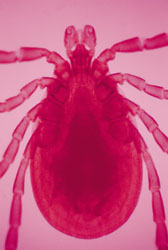U.S. Lyme Disease Cases on the Rise:
How to Avoid This Dangerous Tick-Borne Illness
by www.SixWise.com
Lyme disease, a tick-borne illness that can cause rash, body aches and even temporary paralysis, has been growing in the United States.
In 2007, the most recent year for which data is available, 27,444 cases of Lyme disease were reported compared to under 9,000 in 1993.

Most cases of Lyme disease occur in the late spring and summer months, when ticks are most active and people spend the most time outdoors. |
Lyme disease is caused by a bacterium called Borrelia burgdorferi, which is carried primarily by black-legged ticks (also known as deer ticks). If an infected tick bites you (ticks feed on blood and will attach to a host, including mice, cats, dogs or humans), it can transfer the bacteria through your skin and into your bloodstream.
Tough anyone can get Lyme disease, you are most at risk if you spend a lot of time in wooded or grassy areas where ticks thrive. In the United States deer ticks in particular are most common in the Northeast and Midwest, along with northwestern states like Oregon and Washington.
Symptoms of Lyme Disease
In up to 80 percent of cases, the first sign of Lyme disease is a circular rash that begins at the site of the tick bite (after about three to 30 days). The rash typically widens slowly over the course of several days. Some people also experience:
-
Fatigue
-
Chills
-
Fever
-
Headache
-
Muscle and joint aches
-
Swollen lymph nodes
If left untreated, the infection can spread throughout your body causing more severe symptoms that include:
Keep Ticks Away Safely With All-Natural "Flea 'n Tick B Gone"

Regular tick control products contain a dangerous mix of pesticides and chemicals that can harm your pet, your environment, and your family.
All-Natural Flea 'n Tick B Gone is an ideal alternative because it's an enzyme-based formula made naturally from plant resources and is truly safe enough to spray directly onto your dog (or horse!). Plus, you can use it as an entirely non-toxic, insect repellant for your backyard. Just mist the area and you're tick- and bug-free for at least three hours!
Flea 'n Tick B Gone is:
-
100% Pesticide Free and Non-Toxic
-
Clinically proven to be highly effective
-
A Great Value! Eliminates the need for collars, bombs, foggers, powders, etc., and is economically priced
-
Can also be used on bedding and pet areas of the home -- Simply lightly spray in these areas
-
Reduces vet and medicinal costs
-
Can safely be used as a preventive against fleas and ticks: Regular use can naturally break life cycle of fleas
-
Controls/Stops other in-home pests like ants, bees, flies and more
-
Reduces risk of infections, dermatitis and itching
- Safely removes fleas, ticks, lice and other pests
|
Although these symptoms often resolve without treatment, about 60 percent of people with untreated Lyme disease experience arthritis and severe joint pain and swelling. And in about 5 percent of cases, chronic neurological symptoms may develop, including numbness or tingling in your hands or feet and problems with concentration and short-term memory.
How to Prevent Lyme Disease
If you eliminate the cause then there is no need for a cure, and in the case of Lyme disease the “cause” is a tick bite. So you can drastically reduce your chances of getting Lyme disease by taking the following precautions to avoid exposure to ticks:
-
Protect your pets with All-Natural Flea 'n Tick B Gone. Please AVOID using conventional flea and tick treatments on your pets, as they contain harmful pesticides or chemicals, such as DEET, pyrethrins, synthetic pyrethroids or permethrin, all of which can be harmful and irritating to your pet, the person applying them and our environment.
Instead, use the top-recommended Flea 'n Tick B Gone, which is completely non-toxic, pesticide-free and safe. It can be sprayed directly onto your dog, cat or horse for effective and natural tick control.
-
Protect your outdoor gathering and backyard. All- Natural Flea n' Tick B Gone can also be sprayed around your patio, outdoor gathering, picnic area or entire backyard as a safe way to repel ticks (and also other insects like ants, bees, fleas and more). Simply lightly mist the outdoor area, and all types of bugs will be gone -- and it lasts for a full three hours!
-
Wear long sleeves and pants. When hiking or spending any amount of time in nature, you should cover your arms and legs, and tuck your pants into your socks. This will make it much harder for a tick to attach to you.
What to do if You’ve Been Bitten by a Tick and Suspect You Have Lyme Disease
Keep in mind that just because you’ve been bitten by a tick it does not mean you’ll get Lyme disease. Only certain types of ticks carry Lyme disease, and of them only a minority carry the bacteria.
However, you should see your doctor immediately if you’ve been bitten by a tick and experience signs of Lyme disease because treatment is typically most effective when started early. Lyme disease is typically treated with antibiotics.
Ticks can also transmit other diseases aside from Lyme disease, such as Rocky Mountain spotted fever, anaplasmosis, Tularemia and Colorado tick fever, so if you’re concerned make sure your doctor rules those out as well.
Recommended Reading
Climate Change Causing Increases in Tick-Borne Diseases … What You Need to Know Before Venturing Outside This Spring
How to Recognize and Treat 7 Different Bug Bites
Sources
U.S. CDC, Division of Vector-Borne Infectious Diseases, Lyme Disease
MayoClinic.com Lyme Disease